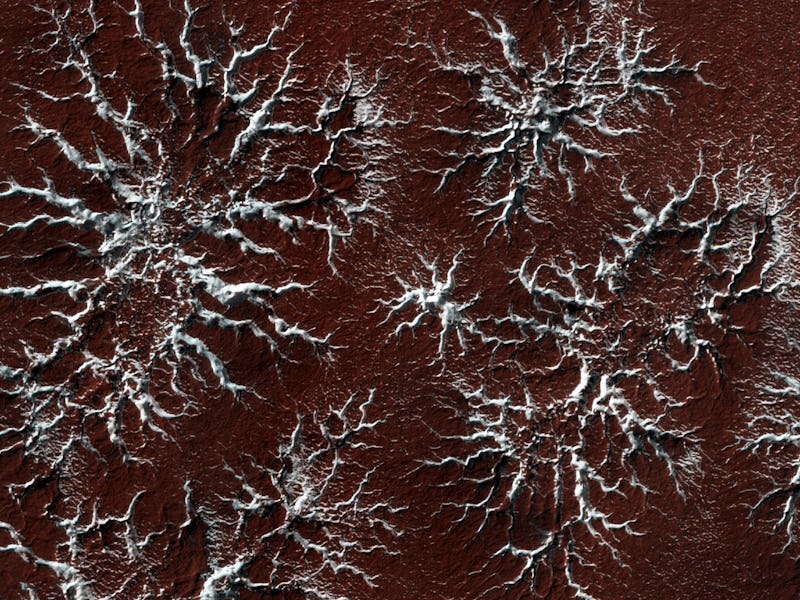Scientists have designed a way to transform water into fuel on Mars
We'll need this if we ever want to set up a Martian colony.

In July, 2008, NASA's Phoenix Mars Lander tasted Mars' soil. The soil, collected from the surface of the Red Planet revealed the elements embedded in the Red Planet's surface — and a clue to how humans might one day find make a life there. Soon after, scientists confirmed what the lander had found — the presence of water ice on Mars.
The discovery changed how scientists study the Red Planet and attempts to reconstruct the history of water on Mars. But it also opened up a new possibility: Could humans make use of this water?
Now, a team of scientists say they have developed a device to turn that water into fuel and oxygen for future missions to the Martian world.
Their work is detailed in a study published Monday in the journal Proceedings of the National Academy of Sciences.
Vijay Ramani, professor at the McKelvey School of Engineering and lead author behind the new study, did not even have Mars in mind when he started working on a device to transform brine water into fuel and oxygen.
"Our initial interest in this technology was not for Mars," Ramani tells Inverse. "But when we read the report on brines on Mars, we thought, 'Let's see if this would work.'"
A panoramic view of NASA's Phoenix Lander on the Martian surface.
Phoenix Lander arrived on Mars on May 25, 2008 as part of a mission to understand the history of water on Mars. The robot discovered the water ice from a soil sample, taken from a two-inch deep trench.
The lander also found evidence of magnesium perchlorate in the Martian soil, an oxidizing agent which dissolves in water, as well as high concentrations of salt.
The magnesium solution can remain in liquid form with the surface temperatures on the Red Planet, which could result in liquid brine on the Martian surface and subsurface.
This brine solution could be converted into hydrogen fuel and oxygen on Mars to serve as resources for future Martian missions, according to the researchers behind this study. Here's how it would work: The water solution enters the device, which has two sides. The first side splits the water to form a hydroxyl ion, and then the second side splits it again to produce the oxygen.
This type of technology already exists on Earth, and is known as an electrolyzer, or an electrochemical device that converts water into hydrogen and oxygen.
To make this technology fit for Mars, the researchers want to create a modular device which can be easily scaled down and transported to Mar. On the Red Planet it would operate on a continuous basis, constantly sucking up brine solution and producing hydrogen and oxygen gas. The device also needs to be able to operate in the freezing temperatures of Mars, which can dip to -81 degrees Fahrenheit.
"If you’re able to build this device and transport it up to Mars, you would have a natural stock," Ramani says.
The researchers hope to collaborate with space agencies like NASA that plan to launch future missions to Mars. This device could be one of the technologies humans will need to bring with them to enable visits to the Red Planet — and fuel trips home.
"We can work in conjunction with all the existing technologies," Ramani says. "It's part of a basket of technologies."
Abstract: NASA’s current mandate is to land humans on Mars by 2033. Here, we demonstrate an approach to produce ultrapure H2 and O2 from liquid-phase Martian regolithic brine at ∼−36 °C. Utilizing a Pb2Ru2O7−δ pyrochlore O2-evolution electrocatalyst and a Pt/C H2- evolution electrocatalyst, we demonstrate a brine electrolyzer with >25× the O2 production rate of the Mars Oxygen In Situ Resource Utilization Experiment (MOXIE) from NASA’s Mars 2020 mission for the same input power under Martian terrestrial conditions. Given the Phoenix lander’s observation of an active water cycle on Mars and the extensive presence of perchlorate salts that depress water’s freezing point to ∼−60 °C, our approach provides a unique pathway to life-support and fuel production for future human missions to Mars.